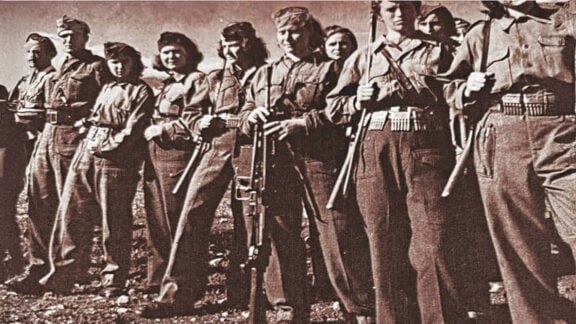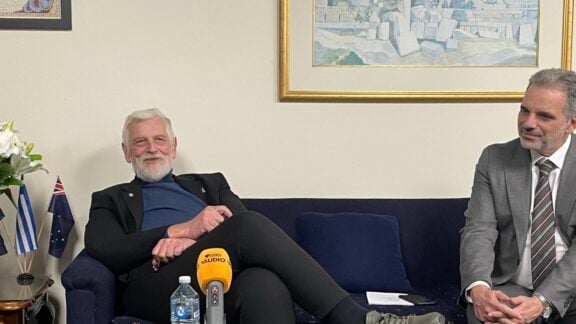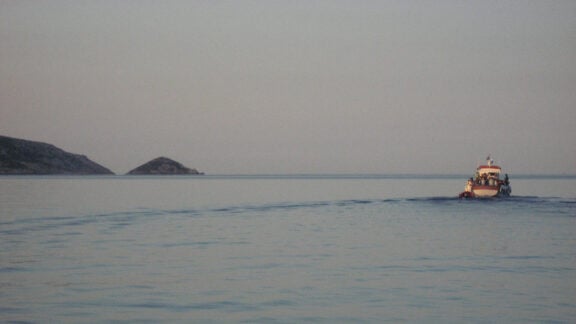On Wednesday April 24, the day before Anzac Day, an Imbros & Gallipoli Exhibition Launch Anzac Day assembly was held at Oakleigh Grammar.
The exhibition reveals the story of the role of the northern Aegean Island of Imbros and its Hellenic population in the Gallipoli campaign through the reproduction of many archival photographs and artworks, all explained by accompanying historical text and specially created maps.

Below is the speech, in its entirety, given to the assembly by historian Jim Clave OAM, who researched and curated the exhibition.
I would like to acknowledge the traditional owners of the land on which we meet and pay my respects to their elders, past, present and emerging.
I would also like to acknowledge my friend Dan Cairnes, a veteran and President of our local Oakleigh Carnegie RSL, who is present with us here today.
Tomorrow is a very special day for Australians – Anzac Day.
It is my honour to be able to address you as part of your Anzac Day assembly.
Like many of your parents, I was born overseas – in Scotland.
I grew up in Australia, not far from here, attending my local primary school in Mount Waverley. Later I would complete two history degrees at Monash University.
One of the things I became keenly aware of when growing up was the significance of Anzac Day.
In many respects it was a defining moment for the people of Australia at the time and points to the continuing remembrance of Anzac Day for generations of Australians – old and new.

On Anzac Day we respect all who have served Australia in the armed services, those who bore the scars of war, those who paid the ultimate sacrifice with their lives and those they left behind in Australia.
It is not a celebration of war. It is a time of remembrance for sacrifice and service.
The day chosen for remembrance is also significant. At dawn tomorrow, we mark the landing of Australian troops on the shores of the Gallipoli Peninsula in April 1915.
They would be the first of 50,000 Australian soldiers and other service personnel who took part in the Gallipoli campaign. Hundreds of these young men – not very much older than yourselves – would be killed or wounded as they struggled to make it ashore. Over 8,000 would be killed, wounded or made sick as the campaign dragged on through nearly 12 months of terrible conflict.
Today we remember these young Australians.
Australians like 21-year-old Sergeant Harry Bick and 25-year-old Private William Withers both with connections to Oakleigh. Both would not survive the horrors of Gallipoli – Harry is buried at Shell Green Cemetery on the Peninsula while William is buried at East Mudros Military Cemetery on the northern Aegean Island of Lemnos where he succumbed to the diseases he had contracted at Gallipoli. William is one of over 1,200 Allied service personnel buried on Lemnos, including 148 Australians.
We remember Australians like Private Peter Rados, a Hellene from Asia Minor, who had come to Australia to make a new life, only to volunteer to return as an Anzac. He was one of twelve Hellenes who served as Anzacs at Gallipoli but he was the only to die there. He is buried not far from where he landed – in the Ari Burnu Cemetery.
We also remember the Australian nurses and other medical personnel who served on Lemnos and the transport ships which brought the sick and wounded from Gallipoli for treatment. Nurses like the 27-year-old Evelyn Hutt from Tasmania who served on Lemnos with 130 other Australian nurses. You can view her important collection of photographs from her service on Lemnos in the State Library of Victoria’s collection, thanks to the generous donation of her family.
And on Anzac Day we also remember that nearly 1 million troops fought on both sides of the conflict, all suffering terrible casualties.

It has been my privilege to have been able to research the role of the northern Aegean Islands in the Gallipoli campaign – in particular Lemnos and Imbros – over the past ten years.
I hope you will all have the opportunity to view the pictorial exhibition now on display at the school library. This tells the role of Imbros in the Gallipoli campaign and Australia’s Anzac story.
In creating this exhibition on behalf of the Imvrian Society of Melbourne – who are based in nearby Parkdale – I have drawn on my researches into the archives of the campaign held across the world as well as from my visits to the Island itself.
I hope that the exhibition provides you with new understanding of the background to and origins of Anzac Day – as well as its impact on the civilians who lived on this Island off the Gallipoli Peninsula.
And I hope that it may encourage those budding historians amongst you to join me in their own journey of discovery into Australia’s Anzac story.
Thank you.
Lest we forget








